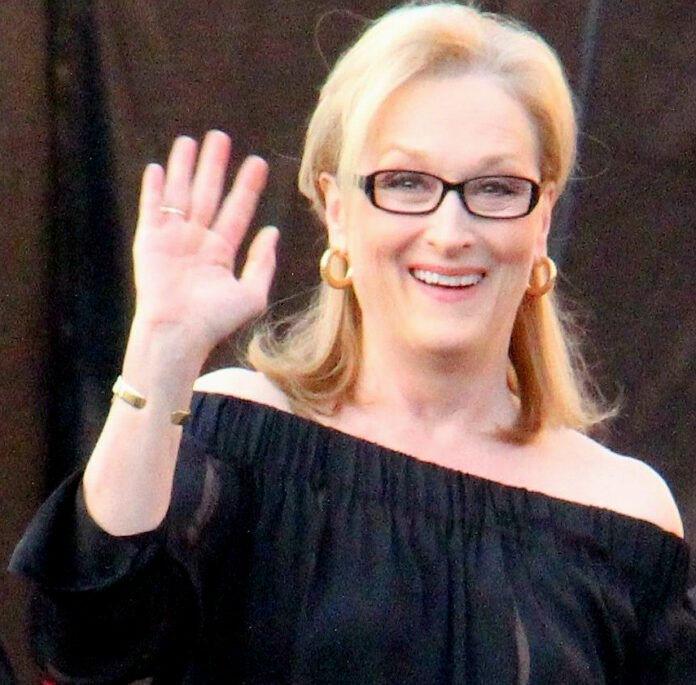At Cannes, Streep discusses the gender pay gap and the progress of women in Hollywood greenlight positions
Meryl Streep, honoured with an honorary Palme d’Or at the Cannes Film Festival, addressed the difficulties male executives and viewers have in seeing themselves in female characters. During a stage interview, Streep shared her experiences and insights on the persistent gender pay gap and the progress of women in Hollywood.
Streep, known for her role as the unwelcoming fashion magazine editor Miranda Priestly in the 2006 hit *The Devil Wears Prada*, revealed that this was the first role that resonated with men in a way she hadn’t experienced before. “It was more than one man that came and said, ‘I know how you felt. I know what it’s like to be the one to make the decisions. And nobody understands you,’” Streep recounted.
Embed from Getty ImagesIn her conversation at the Théâtre Debussy, Streep reflected on how the gender pay gap in Hollywood is not solely about money but also about the difficulty men have in seeing themselves reflected in female roles. “Movies are a projection of people’s dreams, and even executives have dreams,” she said. “Before there were women in greenlight positions at studios, it was very hard for men to see themselves in a female protagonist.”
Streep, who has been a long-time advocate for equal pay in the film industry, noted the contrast in her own experiences. She found it easy to relate to male lead characters, such as those played by Robert De Niro and Christopher Walken in her breakthrough film *The Deer Hunter*, but acknowledged that it is “the hardest thing” for men to identify with female leads.
Despite these challenges, Streep, 74, pointed out that significant progress has been made in the film industry. “There is some progress,” she said. “The biggest stars in the world are women right now, although Tom Cruise is probably way over the top. So many women are producing for themselves. And I’m so in awe of the ones who have done that.”
Streep’s advocacy for gender equality extends beyond her film roles. In 2015, she wrote to individual members of the US Congress, urging support for legislation on equal pay. Research from the University of Huddersfield, analyzing data from 1980 to 2015, found that male Hollywood stars earned $1.1 million more per film than their similarly experienced female co-stars.
Streep’s discussion at Cannes highlights both the strides made and the ongoing challenges in achieving gender equality in Hollywood. Her reflections underscore the importance of female representation in executive roles and the continued push for equal pay and opportunities in the film industry.
Analysis
Meryl Streep’s comments at the Cannes Film Festival provide a critical lens through which to examine gender dynamics in Hollywood. Her reflections on the challenges men face in seeing themselves in female characters and the gender pay gap highlight several important issues.
From a cultural perspective, Streep’s insights underscore the role of movies as reflections of societal dreams and fantasies. The difficulty men have in relating to female protagonists points to deeper cultural norms and biases that shape audience perceptions and industry practices. Streep’s experience with *The Devil Wears Prada* illustrates how certain roles can bridge this gap, offering men a rare opportunity to empathize with female experiences.
Economically, the gender pay gap in Hollywood is a stark reminder of the systemic inequalities that persist in the industry. The $1.1 million disparity in earnings between male and female stars, as identified by the University of Huddersfield, highlights the financial implications of gender bias. Addressing this gap requires not only policy changes but also a shift in how value is attributed to female talent and roles.
Sociologically, Streep’s discussion highlights the importance of representation in executive roles. The presence of women in greenlight positions has begun to change the landscape of Hollywood, allowing for more diverse and relatable female characters. This shift not only benefits women but also enriches the industry by bringing a wider array of stories and perspectives to the screen.
Politically, Streep’s advocacy for equal pay and her engagement with lawmakers reflect the broader movement for gender equality. Her efforts to influence policy underscore the interconnectedness of cultural and legislative change. By pushing for legal frameworks that support equal pay, Streep contributes to a larger effort to dismantle systemic barriers to gender equality.
From a gender perspective, Streep’s comments reveal the double standards and challenges faced by women in Hollywood. Her ability to relate to male characters contrasts with the difficulty men have in seeing themselves in female roles, highlighting the gendered nature of empathy and identification in storytelling. This dynamic underscores the need for more nuanced and diverse portrayals of gender in film.
Race and minority perspectives are also relevant in this context. While Streep’s discussion primarily focuses on gender, the intersection of race and gender in Hollywood is crucial. Ensuring that women of colour and other marginalized groups receive equitable opportunities and representation remains a critical challenge. The progress made by women in Hollywood should be inclusive and reflect the diversity of the broader society.
Theoretically, Streep’s experiences can be analyzed through feminist film theory, which examines the ways in which gender identities and power dynamics are constructed and represented in film. Her comments highlight the importance of disrupting traditional gender norms and expanding the scope of female representation in media.
Overall, Meryl Streep’s discussion at Cannes sheds light on the ongoing challenges and progress in achieving gender equality in Hollywood. Her reflections underscore the importance of female representation in executive roles, the need to address the gender pay gap, and the broader cultural shifts required to ensure that men and women can equally see themselves in diverse and complex characters.
